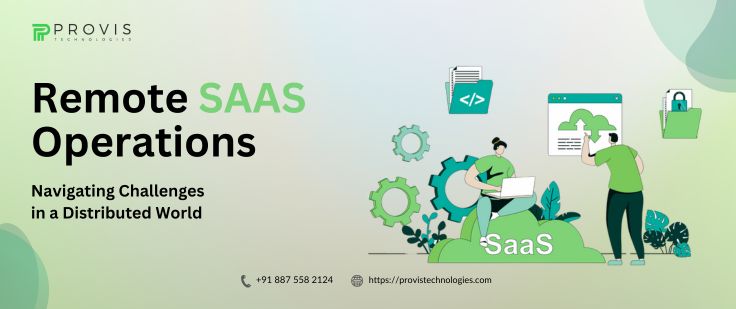In recent years, SaaS space operations have undergone a significant transformation. The traditional office-based model has given way to a distributed workforce where teams collaborate remotely from various locations across the globe. While this shift has brought numerous benefits, it has also introduced a unique set of challenges that SaaS companies must navigate to ensure operational efficiency & success. Today, we will explore some potential challenges associated with remote SaaS operations and discuss strategies to tackle them effectively. Before moving ahead, let’s briefly understand SaaS.
Brief of SaaS
Software as a Service, or SaaS, is a modern method of providing applications & software on the cloud. It allows users to access applications via the Internet on a subscription basis. Unlike traditional software, SaaS eliminates the need for costly installations & updates to offer convenience & flexibility. SaaS enables access to applications from any internet-connected device to users. It’s providers handle maintenance, security, and updates – freeing users from these complex tasks. SaaS also empowers businesses to use high-end technology without the hassle of traditional software deployment.
Hike in Remote Work Environment
The surge in remote work has been staggering – the below statistics reflect its exponential growth.
- According to a recent survey by Gallup, remote work has risen by 67% over the past decade.
- In 2020, amid the global pandemic, remote work skyrocketed – with 88% of organizations worldwide mandating or encouraging remote work, as reported by Gartner.
- In the United States alone, the number of remote workers has more than doubled over the past two years, reaching 42% of the workforce, according to a study by Upwork.
- As we move forward, remote work is expected to continue its upward trajectory, with experts predicting that by 2025, 70% of the workforce will be working remotely at least five days a month, as forecasted by Global Workplace Analytics.
These statistics highlight the seismic shift towards remote work and its enduring impact on the future of work.
Don’t Miss:- How to Develop a SaaS Application? | The Complete Guide
SaaS Remote Work Challenges & Ways to Address
Let’s understand some likely challenges & possible solutions associated with remote SaaS operations.
Communication & Collaboration
One of the most significant challenges of remote SaaS operations is maintaining effective communication & collaboration among team members. With employees spread across different time zones & geographies, establishing smooth communication can be challenging.
SaaS companies must invest in robust communication tools like Slack, Microsoft Teams, or Zoom. Additionally, establishing regular virtual meetings and check-ins can help foster a sense of connection & collaboration among team members.
Security & Data Protection
With remote work comes an increased risk of security breaches and data vulnerabilities. SaaS companies must prioritize cybersecurity measures to protect sensitive customer data & intellectual property. Implementing multi-factor authentication, encryption protocols, and regular security audits are essential in safeguarding remote SaaS operations against potential threats.
Maintaining Company Culture
Building & maintaining a strong company culture can be challenging when employees are not physically present. SaaS companies must find creative ways to encourage a sense of belonging & fellowship among remote team members. Hosting virtual team-building activities, organizing online social events, and celebrating milestones can help reinforce company culture and values even in a distributed work environment.
Managing Remote Teams
Effective team management is crucial for the success of remote SaaS operations. Managers must adapt their leadership styles to accommodate remote work dynamics and provide the necessary support & guidance to their team members. Setting clear goals and expectations, establishing regular communication channels, and providing opportunities for professional development are essential strategies for managing remote teams effectively.
Technical Infrastructure
Remote SaaS operations rely heavily on robust technical infrastructure to support smooth collaboration & productivity. SaaS companies must invest in reliable internet connectivity, cloud-based storage solutions, and remote access tools to ensure team members can access the resources required to complete their tasks. Regularly updating & maintaining technical infrastructure is essential for preventing downtime and uninterrupted operations.
Work-Life Balance
Remote work offers flexibility & autonomy but can also blur the boundaries between work & personal life. SaaS companies must prioritize teams’ well-being by promoting a healthy work-life balance. Encouraging them to establish regular work hours, take breaks, and disconnect after work can help prevent burnout & improve overall productivity.
Must Know:- The Future of E-commerce: Embracing SaaS Solutions
SaaS Benefits in Remote Structure
The remote work structure has fundamentally transformed business operation methods. And SaaS has emerged as a pivotal tool in navigating this new landscape. SaaS offers numerous benefits that are particularly well-suited to remote structures.
Accessibility
SaaS eliminates the need for on-premises installations, enabling smooth access to software from any location with an internet connection. This flexibility empowers remote teams to work efficiently from diverse locations, promoting collaboration & productivity.
Scalability
SaaS providers handle maintenance, updates, and security, relieving businesses of the burden of IT management. This is especially valuable in remote settings, where IT support may be limited. Moreover, SaaS operates on a subscription-based model, allowing businesses to scale their software usage according to their needs, which is cost-efficient.
Sociability
SaaS facilitates real-time collaboration through cloud-based applications, enabling remote teams to work on projects virtually. This fosters innovation & creativity, as team members can smoothly share ideas & feedback regardless of their physical location.
Related Blog:- SaaS Trends 2024: What’s Next in Development?
Bottom Line
The transition to remote SAAS operations comes with its share of challenges; however, with strategic planning & proactive measures – companies can navigate these obstacles successfully. Clear communication, robust cybersecurity measures, a focus on collaboration & team building, their well-being, and performance monitoring are critical aspects to address for a thriving distributed SaaS environment. With the evolution of the business environment, mastering the intricacies of remote SAAS operations is the key to staying competitive & resilient in the modern digital era.
FAQs
How do remote SaaS operations differ from traditional office-based models?
Remote SaaS operations differ from traditional office-based models as they involve teams collaborating from various locations rather than being physically present in the same workspace. This necessitates reliance on digital communication tools and remote access to software & data.
What are the key communication challenges faced in remote SaaS operations?
The communication challenges in remote SaaS operations include –
- coordinating across different time zones
- ensuring effective information sharing, &
- maintaining team cohesion without face-to-face interaction.
How can SaaS companies ensure the security of sensitive data in a distributed work environment?
This can be done by implementing robust cybersecurity measures such as encryption protocols, multi-factor authentication, and regular security audits. They also educate employees about best practices for data protection and enforce strict access controls.
What strategies can be implemented to maintain company culture in remote SaaS teams?
The strategies include –
- hosting virtual team-building activities
- organizing online social events, &
- reinforcing company values through regular communication & recognition of achievements.
What are some helpful methods for managing remote teams in SaaS operations?
Setting clear goals & expectations.
- Establishing regular communication channels.
- Providing opportunities for professional development.
- Fostering a supportive & inclusive work environment.
What role does technical infrastructure play in supporting remote SaaS operations, and how can it be optimized for efficiency?
Maintaining an optimized technical infrastructure is crucial in remote SaaS operations. It can happen by providing reliable internet connectivity, cloud-based storage solutions, and remote access tools. Regularly updating & maintaining technical infrastructure is essential for preventing downtime & uninterrupted operations.
What are other possible ways to handle the SaaS work environment more efficiently?
Taking help from SaaS development IT agencies like Provis Technologies can be the solution. Their expertise will help businesses tackle these challenges in the best way possible.
Written By
Author's Picks
- How to Transition from MVP to Scalable SaaS Without Rebuilding?
- 07/07/2025
- Know About SaaS Development Services A Comprehensive Guide
- 01/11/2023
- The Future of E-commerce: Embracing SaaS Solutions
- 15/04/2024
Categories
- AI for Startups
- AI in Web Development
- AI Integration
- AI Platforms
- AI Prompt
- AI Tools
- AI Trading Software
- Android App
- Android vs iOS Development
- Angular
- API
- API Development
- App
- app development
- App Idea
- App User Feedback
- Application
- Artificial Intelligence
- Audit Services
- Automotive Industry
- Awards and Recognition
- Business Consulting
- Business Website
- Chatbots
- CRM
- CRM for Financial Advisors
- Custom CRM
- Custom SaaS
- Custom Website
- Customer Service
- dashboard design
- Developing a Mobile App
- Digital Business
- E-commerce
- EMR Integration
- Finance
- Financial Advisors
- Financial Advisors
- GIT
- Health Insurance
- iOS App
- iOS App Development
- IoT Mobile App Development
- IoT Platforms
- IT Audit Services
- IT Consulting
- IT Strategies
- Java Development
- Laravel
- Lean Canvas
- Learning Management System
- Logistics Apps
- Mobile App Development
- MVP
- Native App
- News Aggregator Site
- OTT
- Outsourcing IT
- Payment Gateway
- predictive analysis
- Product Launch Strategy
- Progressive Web App (PWA)
- Prototype
- Recommender Systems
- Ruby
- SaaS
- SaaS Application
- SaaS Business
- SaaS Company
- SaaS Development
- SaaS Product
- SaaS Project
- Sales Funnel
- SEO
- Shopping Cart
- Software Development
- SSL and TLS
- Startup Checklist
- Technology
- Tetradic Color Scheme
- UI/UX Design Company
- Unit Testing
- User Flow
- User Testing
- Web Development
- Web Performance Optimization
- website Maintenance Services
- Website Migration Service
- Website Speed Optimization
- WooCommerce
- WordPress





